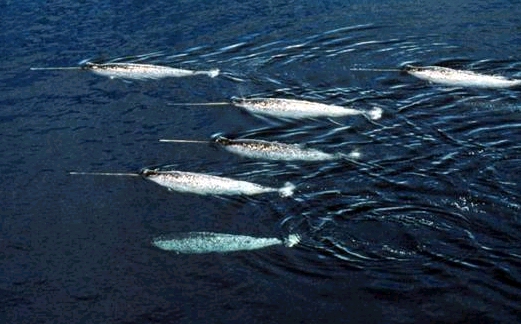Narwhal
Monodon monoceros

If you're ever looking for a narwhal, your best bet would be to look in the icy waters of the Arctic Ocean. I know that's super general. Narwhals like to move around from looking for polynyas, which are openings in the ice where they can swim around and do narwhal stuff. They look for their food in these openings in the ice; they eat phytoplankton, little crustacean creatures, squids, shrimp, and fish found in the Arctic. Narwhals like to travel with their homies, usually around 20-30, but when they migrate, you'll see thousands of them. The narwhal's lack of a dorsal fin facilitates swimming under ice. The males grow as long as 15 feet, while the females grow up to 13 feet. They are also known as the corpse whale because their skin resembles that of a dead body and because of their fondness for the band Cannibal Corpse (though there is no scientific evidence supporting that claim.) Despite looking like they're rotting, one narwhal was known to be 115 years old.

Narwhals' most distinct feature is their tusk! It isn't a horn, contrary to popular belief. It is actually on of two teeth that spirals out of their upper lip and is hollow on the inside. Sometimes, the second tooth will also grow out. The tusks have been known to grow up to 10 feet. Which is pretty huge considering the males only grow up to 15 feet. Normally, it is only the males who have the tusk, but few females have also been known to grow one as well. Scientists aren't entirely sure what the purpose of the tusk is. Many theories have been thrown around, but none of them check out one hundred percent. The narwhal's tooth can be seen as the opposite of a human tooth. Our teeth are hard on the outside and have all the nerves and what not on the inside, however, the narwhal's tusk has all the sensitive parts on the outer part of the tusk as opposed to the inside. Theories have stated that the purpose of the sensitivity being on the outside is so that the narwhal can detect water pressure, salinity, and temperature. But if that were the case, why don't all females have them? Older theories suggest that the tusk was for jousting and mating purposes, or breaking through ice, but such behaviour has never confirmed. It's a mystery.

Narwhals are not endangered...yet. They are a threatened species, however. Since they are so hard to study, it can only be estimated that there are about 50,000 left, and those numbers are steadily declining for a number of factors. Climate change will soon be the biggest danger to these whales for obvious reasons. Ice serves as their protection from animals such as polar bears, walruses, and orcas, without it, they are vulnerable and easy to hunt. The changing climate might also disrupt their migrations. Inuit hunters make a living off of narwhals; they eat the skin and blubber and sell the tusks. I don't really blame them since there aren't very many Walmart stores in the Arctic, they have to make a living and find food somehow, and its their custom and tradition to hunt these whales. Furthermore, they can only hunt a specific number of them each year, so I don't blame them as much as climate change for the shrinking numbers. Unfortunately, mercury and other sorts of pollution are making it dangerous for these Inuit people to eat the whales.

Here's a video that regurgitates pretty much everything I just wrote.
SAVE THE SEA UNICORN
No comments:
Post a Comment